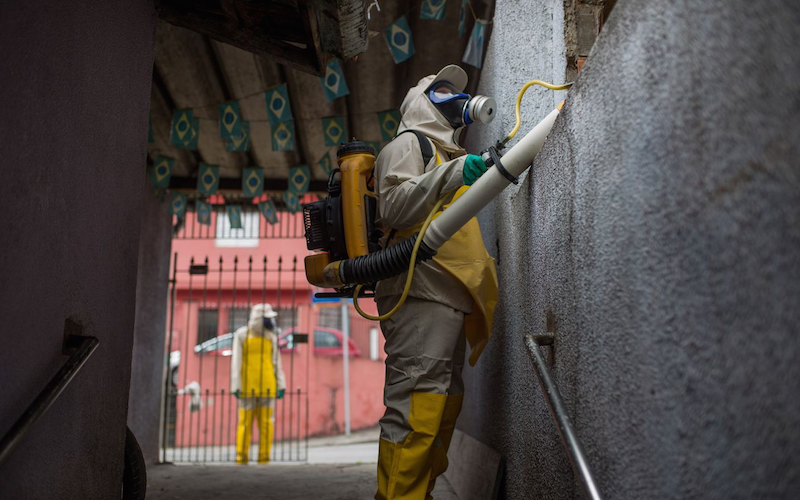
Zika Virus: How Poverty and Politics Will Determine its Social Costs
The World Health Organization’s announcement that the Zika virus could infect up to four million people in the Americas has fueled an arguably disproportionate public reaction to the growing epidemic. Zika, while certainly a cause for serious concern, does not merit the panic that is seemingly being encouraged via the explosion of media coverage that began in late 2015. Panic, while undoubtedly an important factor in encouraging strong state reactions to the outbreak, is likely to lead to political responses to Zika in the short term – visible measures such as airport screenings, quarantines, and awareness campaigns – rather than a more rational and sustainable approach to confronting the root causes of the epidemic.
Zika is a part of a class of afflictions termed diseases of poverty that are endemic in poor regions where a lack of public health infrastructure allows illnesses to spread without significant resistance. The Zika virus is carried by mosquitos of the genus Aedus – which includes the mosquito species responsible for spreading dengue and yellow fever. Populations of these mosquitos thrive in areas such as Brazil’s sprawling favelas, bolstered by factors including an abundance of stagnant water, poor sanitation, and a high population density.
The same poor communities that are likely to be impacted the most severely by Zika are also among the least well-equipped to confront the disease. Good public health infrastructures aren’t created overnight, and it may be many decades before conditions in Brazil’s favela communities improve to the point where diseases like Zika can be effectively contained and treated on a local scale.
When confronted with the specter of an impending epidemic, policymakers really face two challenges: first, the question of how to actually prevent the spread of the disease, and second, how to most effectively placate the concerns of the voting public.
While the former concern is undoubtedly more important in terms of reducing the total public health impact of a disease, the latter concern should not be dismissed as a mere exercise in political self-preservation. Fear of a disease, which oftentimes can prove more infectious than the disease itself, can and does have real negative economic and social effects.
In the most extreme cases, fear of disease can paralyze a country’s economy and overwhelm its social structure to the point of crisis – as we have seen in West Africa in the wake of the Ebola epidemic. Regardless of motivation, state actions intended to quell fears are generally good both for business and social wellbeing.
The real danger emerges when efforts to avoid a panic stand in the way of good public health policy. Implementing infection screenings and travel bans may create a false sense of security, leading people in areas perceived as safe to falsely believe that they aren’t at risk, thereby encouraging riskier behavior and increasing the odds of infection. Simple steps such as governments encouraging citizens to practice good hygiene, to avoid potentially sick individuals, and to report symptoms of disease can go a long way in terms of slowing the spread of an epidemic without necessarily causing an outright panic.
Given that Zika’s geographic spread seems increasingly unavoidable, governments now need to anticipate where the disease is likely to incur the greatest costs, and to plan accordingly. If avoidance is unrealistic, preparedness is the next best strategy.
Poverty will be a critical factor in determining where the virus will hit the hardest. In Brazil, the experiences of different communities both confronted by Zika can vary astoundingly depending on wealth. Brazil’s abysmal performance in income inequality rankings highlights the challenge the country faces; although Brazil is not among the world’s poorest countries in absolute terms – placing, in fact, just above the world average for per-capita GDP – the concentration of prosperity among relatively small pockets of the population nonetheless means that millions of Brazil’s poorest live in conditions well below what should be considered acceptable. These poor communities are disproportionately receptive to diseases like Zika, and are likely to absorb a disproportionate share of the disease’s costs.
Unfortunately, Zika is likely poised to exacerbate existing inequalities between rich and poor regions internationally as well as on a domestic scale. When the costs of a disease are not distributed across a national population, vulnerable groups are forced to contend with not only the disease itself, but also the consequent socioeconomic fallout.
Epidemics are not, of course, a zero-sum game. The refusal of a wealthy community to share the resources necessarry to combat a disease will only make that community healthier relative to poorer communities – in absolute terms, an unchecked outbreak of a disease in any community makes all other communities more vulnerable to infection.
Mosquito-borne diseases cost at least hundreds of thousands, and possibly millions of lives annually – reliable figures are hard to come by due to a lack of accurate reporting. Even conservative mortality estimates still make mosquitos the deadliest animal on the planet by a long shot. The economic and social tolls exacted by these diseases are an intractable barrier to development for a significant portion of the world. In Africa, where 9 in 10 global cases of malaria infection occur, the annual direct economic cost of the disease is estimated at $12 billion USD. This estimate includes only the medical costs of treating malaria patients, excluding significant indirect costs such as the lost economic output resulting from roughly 200 million annual cases of malaria infections.
To help anticipate the future impact of Zika, it is useful to examine the epidemiology of dengue fever. The Zika virus is closely related to the virus that causes dengue, and its symptoms are noted as similar.
Dengue has plagued poorer regions of the world for centuries. Originating in Africa, the dengue virus was spread around the world beginning in the 15th century with the advent of the transatlantic slave trade. The Aedus mosquitos that carry dengue thrived amidst ecological disruption in the 20th century, capitalizing on emerging trends in globalized transportation to access new corners of the world. As human populations became more concentrated in urban centers, dengue outbreaks became increasingly common, especially in areas where poor public sanitation systems allowed mosquitos to flourish. Aedus mosquitos can only survive in warm climates, which historically has limited the geographic reach of dengue to within a broad equatorial band. Now, however, climate change is gradually allowing mosquitos to survive at higher latitudes, increasing the odds of disease outbreaks in areas including Europe and North America.
Zika’s geographic footprint is likely to come to resemble dengue’s, although the virus has yet to spread significantly beyond its foothold in the Americas to infect Sub-Saharan Africa, South Asia, or Southeast Asia.
Despite a lower morbidity rate, dengue probably exceeds malaria in terms of total human and economic impact. The WHO has labeled dengue as the most important mosquito-borne viral disease in the world, citing a 30-fold increase in dengue infections in the last half-century. Up to 3.6 billion people – roughly half of the world’s total population – live in areas that place them at risk of contracting dengue. Annually, an estimated 230 million people are infected with dengue, resulting in significant direct medical and indirect socioeconomic costs for affected communities.
The specific costs associated with the Zika epidemic will also be influenced by the characteristics that distinguish Zika from dengue. The ostensible – if not yet officially proven – link between Zika and infant microcephaly (abnormal smallness of the head) may result in public health emergencies in Brazil and other regions where the disease is likely to continue to spread. A rash of microcephaly cases linked with a Zika outbreak could conceivably overwhelm public health infrastructures in the short term, reducing these systems’ effectiveness while imposing the long-term burden of disease-related costs upon communities.
The notion of a disease that is able to spread invisibly (many infected with Zika show little to no symptoms) yet which may cause debilitating birth defects is certainly frightening, but rather than feeding a panic, this prospect should rather serve a constructive purpose by encouraging sensible state responses that are proportional to the threat.
To be as effective as possible, any plan to reduce the total human costs of Zika must take into account Zika’s origins as a disease of poverty. The developed world is not immune from diseases that emerge in poor countries. As long as living conditions in communities like Brazil’s favelas allow diseases and vector species like mosquitos to thrive, new pandemics will continue to be spawned. The enduring struggle between man and microbe pivots on each side’s ability to adapt. With this in mind, even modest upgrades to local health and sanitation systems in vulnerable areas would be immensely impactful in terms of reducing the human cost of future diseases.
